
Photo: ProvenWinners.com
1 / 26
Drought-Tolerant Can be Colorful + Beautiful
Whether you’re dealing with water restrictions or lack of rain, it’s still possible to create the yard of your dreams with drought-resistant landscaping techniques. You can craft inexpensive drought-tolerant landscaping using simple methods that aren’t tough to implement or adopt practices that demand a little more time and effort.
This pretty front yard fits into the inexpensive drought-tolerant landscaping category. A planting bed brims with colorful, low-water-use plants including perennial Russian sage (Perovskia atriplicifolia ‘Denim ‘n Lace’) and annual zinnias. Both of these bloomers boast drought and heat tolerance and stage a stunning show even when the rain gauge is on the low side. Keep reading for more drought-tolerant landscaping ideas.
More photos after this Ad

Replace the Grass
This drought-tolerant front yard gushes with cottage garden charm thanks to lush, low-water plantings that include shrub and climbing roses, pink alstroemeria and Mexican bush sage. The space trades thirsty turf for a stone patio, which allows precious rainfall to seep into cracks between stones to irrigate the landscape. Bright Adirondack chairs add another splash of steady color to the drought-tolerant front yard.
Learn More
More photos after this Ad

Use Gravel as Mulch in Xeriscape
Water-permeable surfaces like gravel and stepping stone paths are key hardscape components of drought-tolerant landscaping, allowing rain or irrigation to reach the soil. Gravel is a common mulch in a xeriscape, which is a type of low-maintenance drought-tolerant landscaping that survives on rainfall, even in arid regions. These plantings include cactus, Mediterranean native plants and succulents like agave that thrive with little rainfall.
Learn More
More photos after this Ad

Adopt Mediterranean Style
A combination of succulents, ground cover, asparagus fern and ornamental grasses fill this drought-tolerant garden with shades of silver and green. Stepping stones form a water-permeable path, and a ground cover helps cool soil by slowing water evaporation from the soil surface. A birdbath with a fountain adds the sound of trickling water, beckoning birds for a sip and dip.
Learn More
More photos after this Ad

Photo: Scott Dressel-Martin for Denver Botanic Gardens
5 / 26
Use Boulders for Height + Texture
Boulders and stones are a natural choice for a drought-tolerant garden, providing sculptural focal points that help fill a planting area — and don’t need water to look good. Low-growing alpine plants and ground covers soften the stones and blanket soil, helping to cool it and retain moisture. This large rock garden is part of the Denver Botanic Gardens’ drought-tolerant landscaping display, but the concept is easily scaled to suit a typical yard. Best of all, once established, rock gardens are low maintenance.
Find More Ideas
More photos after this Ad

Photo: Julie Martens Forney
6 / 26
Add Sculpture for Interest
Count on sculptures to take up space and look great in a garden — zero water is required. This oversized container set into a bed of gravel and surrounded by metal pillars stages an eye-catching focal point in a garden. Adding ground covers that don’t demand heavy watering — in this case, creeping thyme — softens the hardscape. On this garden’s gentle slope, the ground cover also helps slow water runoff during rain, giving the soil a chance to absorb it.
Learn More
More photos after this Ad
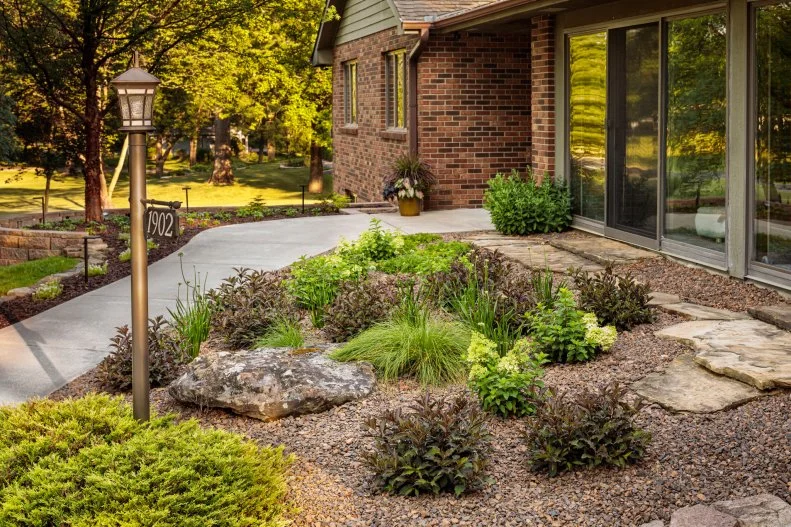
Photo: ProvenWinners.com
7 / 26
Reduce Lawn
One of the largest water guzzlers in a typical yard is grass. Many grass types need consistent irrigation to stay green during a typical summer, let alone in drought conditions. By shrinking the amount of turf you tend, you immediately reduce your yard’s irrigation needs. Replace the lawn with an eye-catching mix of seasonal flowering shrubs, ornamental grasses and native stone. Add a rock mulch, and you have front yard drought-tolerant landscaping that looks great and never needs mowing.
Learn More
More photos after this Ad

Photo: Holly Lepere
8 / 26
Add a Water Feature
A water feature might seem at cross purposes with a drought-tolerant landscape, but moving water is an attractive hardscape element that delights the senses. With a large enough reservoir basin, a water garden can capture rainfall for re-use or simply act as a rain garden to slow down and capture surface runoff.
Find More Ideas
More photos after this Ad
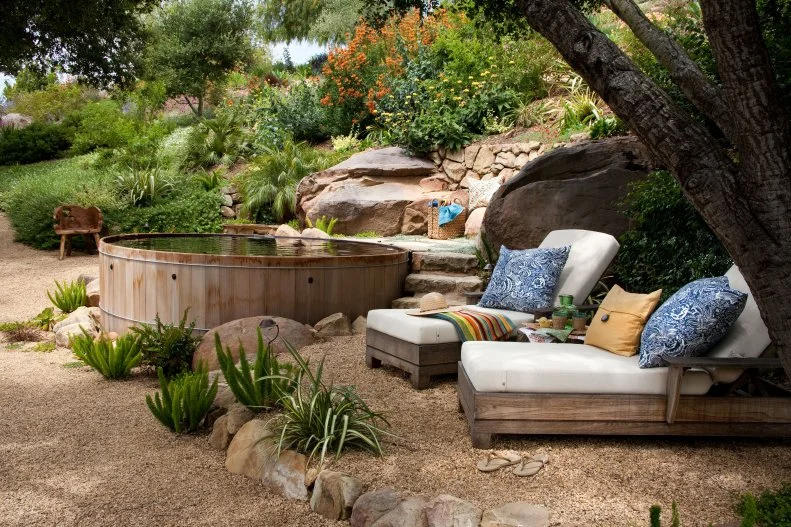
Photo: Holly Lepere
9 / 26
Add More Hardscaping Features
When designed with an eye for beauty, a swimming pool or spa can also pull its weight as a sculptural piece of hardscape. This backyard features a slope, which is tamed with terraces that host drought-tolerant plantings and outdoor living areas. The combination of plants, gravel mulch, boulders and terraces turns this hillside into a drought-resistant landscape that slows and captures rainwater while preventing soil erosion.
Find More Ideas
More photos after this Ad

Photo: ProvenWinners.com
10 / 26
Create Terraces
Divide and conquer a slope by creating terraced planting beds and filling them with lush gardens. These beds headline a who’s who of drought-tolerant plants, including variegated agave; low-growing portulaca, ice plant and sedum; drifts of yellow and scarlet blanket flower; and red hot poker plants. Drought-tolerant plants handle reduced watering once they’re established in the landscape. Get plants off to a great start by watering a few times a week for the first two to three weeks after planting, then slowly reduce watering over the course of a month.
Find More Ideas
More photos after this Ad

Photo: Anthony Tesselaar Plants at Tesselaar.com
11 / 26
Keep Roses in the Picture
Once established, many roses can tolerate drought. One type is a ground cover rose known as ‘Flower Carpet Rose.’ This particular variety is ‘Flower Carpet Rose Pink.’ To coax this rose to its fullest drought-tolerant potential, plan on watering it during the first season of growth to help establish a strong root system. In future growing seasons, it will thrive on rainfall, except in the most arid climates. Pair it with lavender for beautiful drought-tolerant landscaping.
Learn More
More photos after this Ad

Photo: ProvenWinners.com
12 / 26
Mulch, Mulch and More Mulch
A mulch layer is one of the key practices for maintaining drought-resistant landscaping. Mulch moderates soil temperature and helps slow water evaporation from the soil surface. Choose an organic mulch, like shredded bark, pine straw or bark fines, materials that slowly break down over time. Or use an inorganic material that’s permanent, like gravel or crushed stone. This bed glows with the sunny blooms of heat and drought-tolerant ‘Tuscan Sun’ perennial sunflower (Heliopsis helianthoides).
Learn More
More photos after this Ad

Photo: Scott Dressel-Martin for Denver Botanic Gardens
13 / 26
Plant Densely
When designing drought-tolerant landscaping, arrange plantings so that when they reach their mature size, they’ll cover open soil. The result is not only a lush and lovely garden but also a planting that doesn’t need lots of irrigation because the soil is shaded. Covered soil stays cool, losing less water to evaporation on sunny days. The drought-tolerant plants in this garden include different types of sage (Salvia), agastache, columbine, California poppy, false indigo and euphorbia.
Learn More
More photos after this Ad
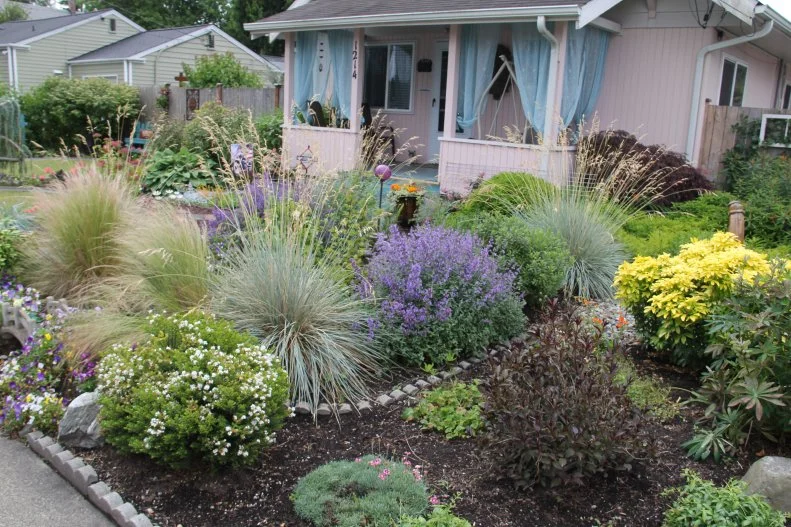
Photo: Rain Dog Designs, Gig Harbor, Washington
14 / 26
Make a Rain Garden in the Sun
A rain garden provides a pretty, practical way to reduce water runoff, whether it’s during a typical spring shower, a prolonged rain event or a summer thunderstorm. Rain gardens adapt readily to any part of a yard and look good enough to hold their own even in a front yard, where they can easily replace lawns with drought-tolerant plantings.
Learn More
More photos after this Ad

Photo: ProvenWinners.com
15 / 26
Make a Rain Garden for Shade
Transform a grassy spot along a drive into a rain garden that helps capture rainwater runoff from the driveway surface. By directing runoff from a solid surface into a rain garden, you can transform a swath of lawn into a colorful planting area that survives on rainfall. This type of drought-tolerant landscaping is lush and inviting, rich with variegated foliage that looks great all season long.
Learn More
More photos after this Ad

Photo: Mark Tessier Landscape Architecture
16 / 26
Don’t Forget the Side Yard
In a warm climate, a side yard turns into a spectacular drought-tolerant landscape with a pathway of evenly spaced concrete slabs edged with dwarf mondo grass. The rest of the plantings include agave, New Zealand flax, dracaena, cycad and society garlic, which combine to create a low-maintenance landscape that survives on rainfall and makes the lawnmower obsolete.
Find More Ideas
More photos after this Ad
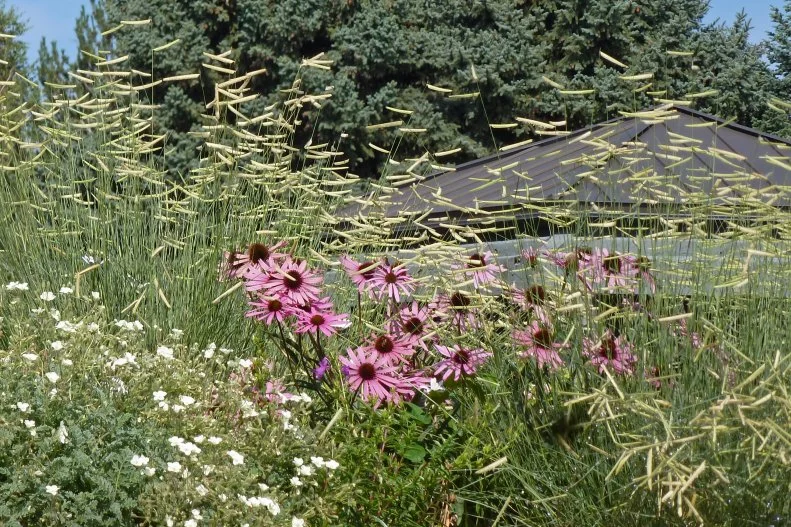
Photo: BlondeAmbitionGrass.com
17 / 26
Go Native
Many native prairie plants stand up to limited rainfall or irrigation, creating gorgeous drought-tolerant landscaping. ‘Blonde Ambition’ grass (Bouteloua gracilis) and Tennessee purple coneflower (Echinacea tennesseensis) are the stars in this planting, with deep root systems that seek out moisture far below the soil surface. Ornamental grasses bring multi-season interest to the garden, and ‘Blonde Ambition’ is no exception, with seed heads on stiff stems that stand up to Rocky Mountain snows.
Learn More
More photos after this Ad

Photo: PlantSelect.org
18 / 26
Keep It Simple
With drought-tolerant landscaping, you can draw from many different plant groups to create a garden that appeals to your sense of style and suits your growing conditions. This hillside looks terrific year-round with a simple plant palette that boasts drought tolerance as one of its main characteristics. Rugged boulders stage informal terrace walls, providing planting pockets for evergreen spruce. Ornamental grasses, including pink muhly grass (Muhlenbergia reverchonii ‘PUND01S’) add contrasting color and texture to the scene.
Find More Ideas
More photos after this Ad

Keep It Low to the Ground
A sidewalk can easily accommodate drought-tolerant design. Here, paver slabs alternate with gravel that creates openings for rainwater to soak into the soil and help nourish nearby plants. These walkway plantings stay low and stand up to drought. The mix includes blue fescue ornamental grass, blue chalk sticks and ground-hugging thyme.
Find More Ideas
More photos after this Ad

Plant a Driveway
Adding a planting strip to a driveway perfectly illustrates the drought-tolerant landscaping principle of creating a way to capture surface runoff during rain events. Alternatives to a planting area are porous pavers that establish a hard-driving surface interspersed with turf. It’s a snap to mow and keeps all rainwater on site.
Find More Ideas
More photos after this Ad
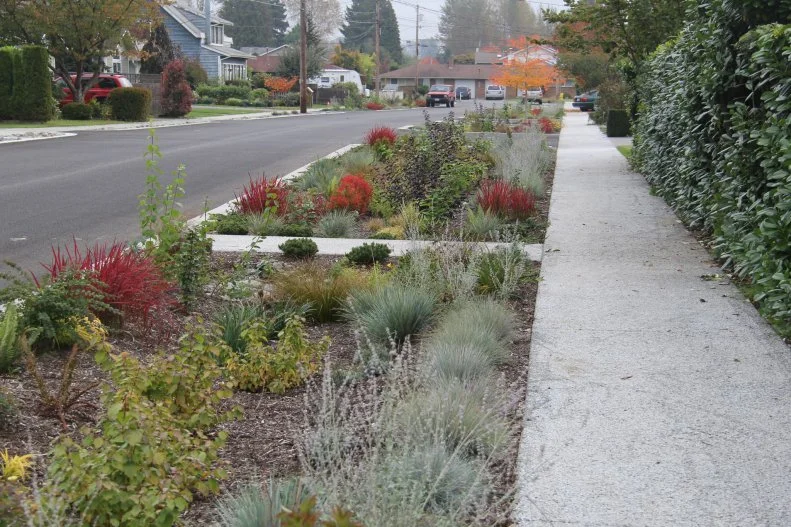
Photo: Rain Dog Designs, Gig Harbor, Washington
21 / 26
Drought-Proof Your Parking Strip
Forget mowing the space between the curb and sidewalk — give up grass and add drought-tolerant plants. This parking strip features a rain garden that helps slow down, catch and absorb rainwater runoff from the sidewalk. It’s a brilliant strategy to deal with an often-nasty and neglected planting area.
Find More Ideas
More photos after this Ad

Photo: ProvenWinners.com
22 / 26
Keep Water Moving
Evaluate all hardscape elements — from outdoor furniture to pathways — and select ones that feature openings for water to move toward the soil. This seating area includes many drought-tolerant landscaping features: reduced lawn, a patio with a small footprint and a path that lets water run to the soil.
Find More Ideas
More photos after this Ad

Photo: Gardeners Supply Company at Gardeners.com
23 / 26
Add Compost to Soil
One of the best ways to help your soil nourish drought-tolerant plants is by adding compost. This organic material acts like a sponge in soil, helping to absorb moisture when it’s available and then releasing it to plant roots as the soil dries out. Using compost is a good tactic to help create low-water-use landscapes. Make your own compost, source it commercially or participate in a community yard waste program that offers free compost.
Learn More
More photos after this Ad

Photo: ProvenWinners.com
24 / 26
Create Watering Zones
As you design drought-tolerant landscaping, it’s important to group plants that have similar water needs. You might have a cutting garden that needs more water or a perennial planting like this one that, once plants are established and soil is mulched, survives on rainfall except in times of extreme drought. The plants here include purple ‘Serendipity’ ornamental onion, ‘Lemon Squeeze’ Prairie Winds fountain grass and ‘King of the Ages’ daylily.
Learn More
More photos after this Ad
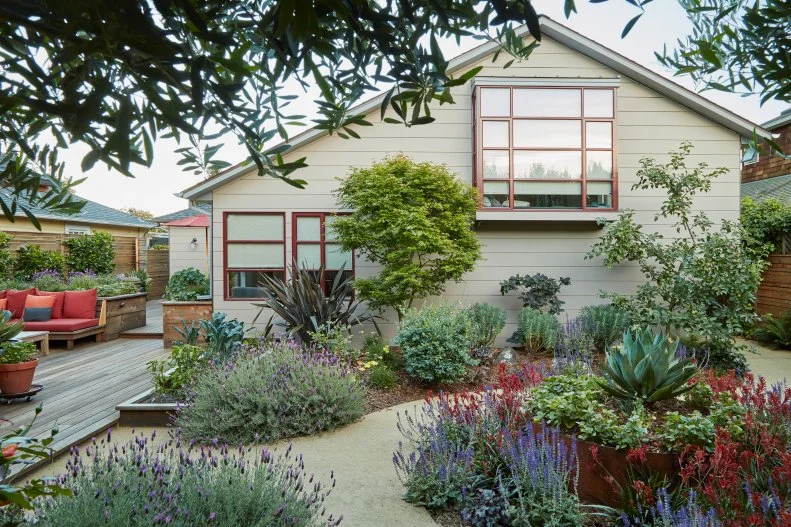
Select Colorful Choices
A yard without lawn might sound bleak, but this gem proves that drought-tolerant landscaping can sparkle. Edible plants combine with lavender, New Zealand flax, kangaroo paw, agave and other drought-tolerant beauties to form a garden that offers lovely color no matter the rainfall. Mulched beds and a crushed gravel path ensure that rain makes its way to the soil below.
Learn More
More photos after this Ad

Add Other Natural Elements
No matter where you garden, there’s a drought-tolerant landscaping style that can transform your yard into your favorite beauty spot. The simple combination of a natural boulder, round river rock and a custom-plumbed stone fountain creates a stunning scene that sets the stage for the vista beyond. This arid environment nurtures drought-tolerant plants like agave, native grasses, pincushion flower (Leucospermum) and aloe.
Learn More

